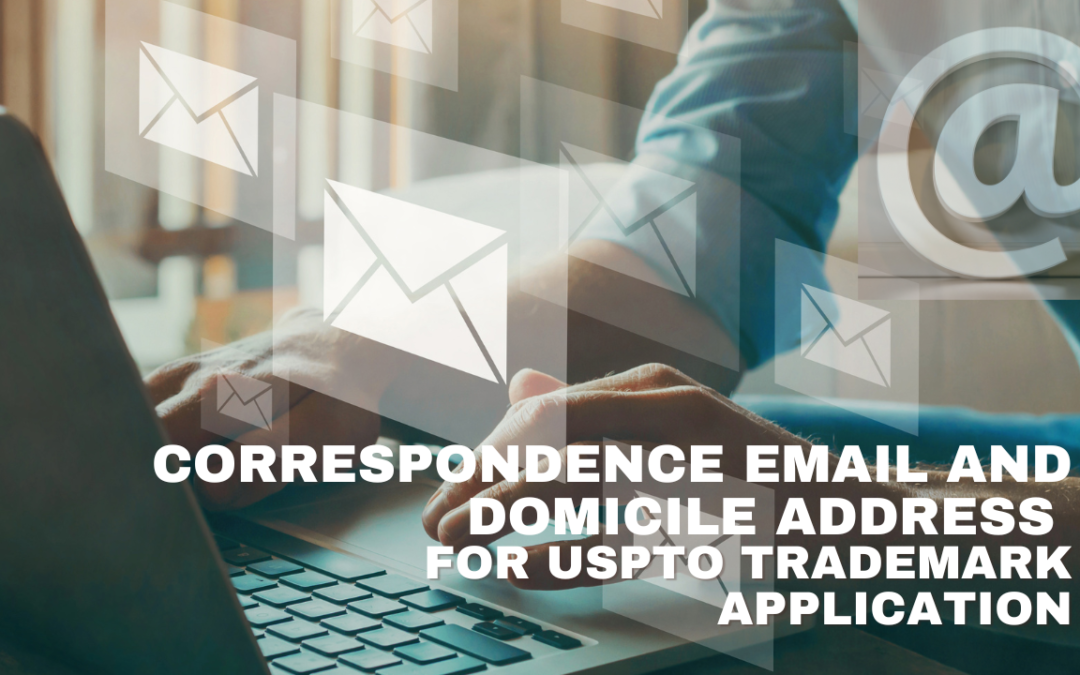Have you ever applied to register a trademark with the United States Patent and Trademark Office (USPTO)? If so, you may have noticed that there are two fields on the application form labeled “Correspondence Email” and “Domicile Address.” But what do these fields mean? And what should you enter in them? Here’s a quick guide to help you out.
We’ll keep it simple. As part of the trademark application series, let’s review a crucial part of your trademark application: a correspondence email and domicile address.
An applicant for a trademark with the United States Patent & Trademark Office (“USPTO”) must submit the owner’s email and domicile address.
Correspondence email:
The email used for correspondence depends on whether the applicant has hired a trademark attorney.
Trademark applicants who have retained the counsel of a qualified US Attorney MAY provide an email address as the owner’s email. Although all correspondence with the USPTO will be between the examining attorney at the agency and the applicant’s attorney, USPTO examining attorneys prefer to have only one channel of communication. The email provided in the owner’s field cannot be the same as the email provided for correspondence. The owner’s email will not be visible to the public, whereas the trademark attorney’s correspondence email will.
Trademark applicants without a US Attorney will need the owner’s email and correspondence email to be the same. It is often advised that applicants create a unique email only for USPTO-related matters, as the email an applicant provides for correspondence will be publicly viewable. Please be aware that an applicant is more likely to receive unsolicited emails due to the public nature of the correspondence email.
Domicile Address of Applicant:
A domicile is a permanent address with a substantial connection to the applicant.
The address must be kept current throughout the ownership of the applied-for mark.
The domicile determines if an applicant must retain a US-qualified attorney. All foreign applicants must retain US counsel.
- An individual applicant must provide either the business address or the residence address.
- A corporation, on the other hand, should provide the business address, be it in the state of incorporation or where it conducts a substantial amount of its business.
- A joint applicant must provide the address of each party.
Do not lie!
The USPTO will conduct a preliminary check to see if the address provided is related to the applicant’s business. Suppose the address provided is that of a third-party commercial mail-receiving agency and is not the applicant’s permanent legal place of residence or principal place of business. In that case, the applicant is almost guaranteed to receive an office action asking the applicant to clarify or correct the address provided, further delaying your application process.
I hope this information regarding the trademark application process was helpful. The trademark process can be a confusing and daunting one.
If you have any other questions about the trademark application process or need help filling out your application, don’t hesitate to reach out. Our team at Drishti Law is more than happy to help. In fact, we offer a free 30-minute discovery call so we can better understand your business and trademark protection needs. Don’t let the confusion stop you from moving forward with protecting your brand—schedule a discovery call today.
We want to make the trademark process simple and efficient for you, so if there’s anything we can do in order to help with your situation please don’t hesitate. We’d be happy to schedule a discovery call with you. During this call, we can discuss your business needs in more detail and come up with a plan tailored specifically for you.
DISCLAIMER: The information in this blog is not intended nor implied to be a substitute for professional legal deliberation, deposition, or procedure. All content, including text, graphics, images, and information, contained in this video is for general informational purposes only and does not replace a consultation with your own attorney.
DrishtiTalks is made available by the law firm, Drishti Law, LLC, for educational/informational purposes. The intent of DrishtiTalks is to provide a general understanding of the law and not to provide legal advice. The use of this site, commenting on posts, or sending inquiries through the site or contact email, does not confirm an attorney-client relationship between you and the Blog, DrishtiTalks, or Website publisher, Drishti Law, LLC. The Blog/Website should not be used as a substitute for competent legal advice from a licensed attorney in your jurisdiction.

Sahil Malhotra
Sahil Malhotra is an Intellectual Property Attorney, who founded Drishti (“vision”) law because of his vision in protecting dreams and ideas.
He provided individuals and small businesses with an opportunity to enhance their IP’s value by helping them register trademarks and successfully argue against office actions. In addition to his training and experience, he has been deeply involved in the multifaceted IP portfolio at UIC and continues to be associated with IP organizations and conferences.
To know more about Sahil Malhotra — Click Here
You may follow Sahil Malhotra on Facebook: Sahil Malhotra and on Instagram: @Sahil Malhotra

